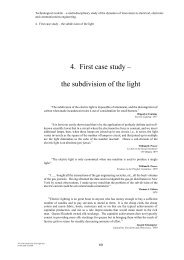Valuation Techniques for Social Cost-Benefit Analysis: - HM Treasury
Valuation Techniques for Social Cost-Benefit Analysis: - HM Treasury
Valuation Techniques for Social Cost-Benefit Analysis: - HM Treasury
You also want an ePaper? Increase the reach of your titles
YUMPU automatically turns print PDFs into web optimized ePapers that Google loves.
Finally, a paired comparison exercise involves respondents choosing their favourite alternative<br />
out of a set of two and then indicating the strength of their preference on a numeric or<br />
semantic scale.<br />
The key questionnaire design stages that are specific to choice modelling studies are:<br />
selecting the attributes of the good;<br />
assigning levels to the attributes;<br />
creating the alternative descriptions of the good; and then<br />
constructing the specific choices that are presented to respondents.<br />
Attributes are typically chosen through literature reviews, focus groups, and interviews with<br />
policy makers. The attributes of the good that people attach value to and the attributes that<br />
may be affected by any policy are those that are relevant. As noted above, a monetary cost<br />
(price) must be one of the attributes in order to derive WTP estimates. The levels that the<br />
attributes take should be realistic and span a sensible range. The total possible number of<br />
alternative descriptions of the good is determined by the chosen number of attributes and the<br />
chosen number of levels that each attribute can take. Finally, a number of specific choices<br />
(choice sets) are constructed.<br />
Applying Revealed Preference Methods<br />
A number of papers provide a more detailed introductory treatment of a number of areas<br />
covered here. Parsons (2003) provides a detailed practical overview of the key steps involved<br />
in applying the travel cost method. Taylor (2003) focuses on the practicalities associated with<br />
the valuation of environmental amenities using housing markets. Sheppard (1997) also<br />
presents a useful primer on the theoretical foundations and implementation of the hedonic<br />
analysis of housing markets. The main issues arising with the use of labour markets to<br />
estimate the statistical value of a life is covered by Viscusi (1993) and Viscusi and Aldi (2002).<br />
The Hedonic Pricing Method<br />
The hedonic pricing method derives estimates of the value of a non-market good through<br />
observations on real choices made in actual markets. Housing and labour markets are the most<br />
common applications. In the <strong>for</strong>mer, the intuition is that the price differential between<br />
otherwise identical houses that differ in their exposure levels to non-market goods and ‗bads‘<br />
such as pollution, noise, crime or education facilities reveals in<strong>for</strong>mation regarding individuals‘<br />
WTP <strong>for</strong> such goods. Labour market applications follow a similar logic, though the focus is<br />
typically on the compensating wage differentials that are paid in relation to job characteristics<br />
such as health and safety risks or job security.<br />
Theoretical Foundations<br />
Viscusi (1993) presents a useful overview of the main elements of the basic theory <strong>for</strong> labour<br />
market applications. This is captured here in order to provide a basis <strong>for</strong> understanding issues<br />
related to the methods application. In brief, the model relates to the trade-off that the supply<br />
and demand side of the labour market makes over wage (w) and job-characteristic (r)<br />
combinations. For example, <strong>for</strong> any given firm to offer less injury risk to its workers while<br />
maintaining the same level of profits, it will have to offer a lower wage rate. Each firm has<br />
there<strong>for</strong>e has a wage-risk offer curve. Since any worker will select the highest possible wage <strong>for</strong><br />
a given level of risk, the outer envelope of each firm‘s offer curve gives the market opportunities<br />
locus. On the supply side, each worker will have their own preferences over risk/wage trade-offs.<br />
However, all will be willing to give up some wages <strong>for</strong> some reduction in risk probability. The<br />
59





![AIRTO [Professor Dr Brian Blunden] - HM Treasury](https://img.yumpu.com/15492848/1/184x260/airto-professor-dr-brian-blunden-hm-treasury.jpg?quality=85)










